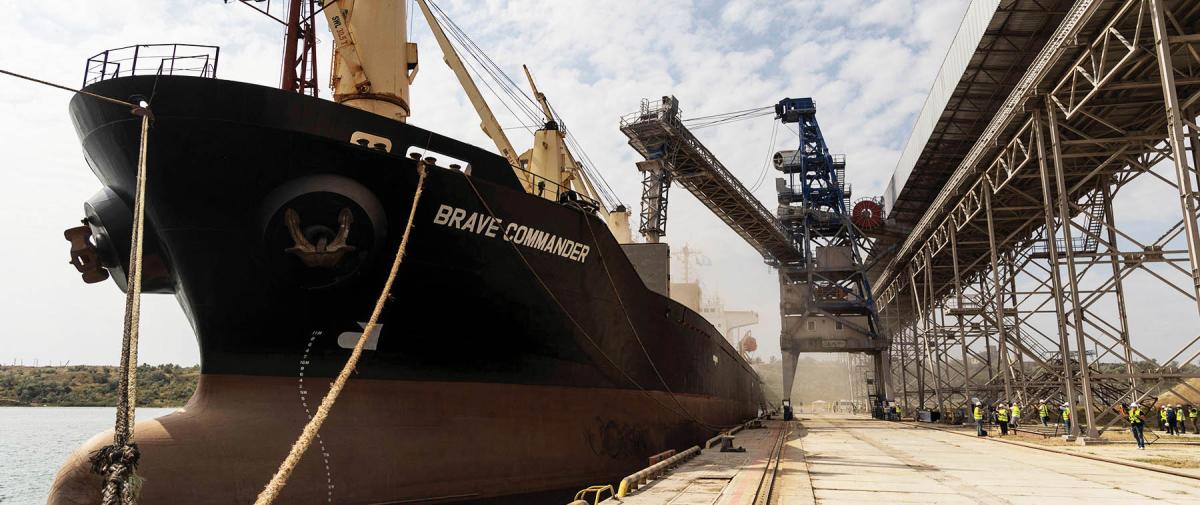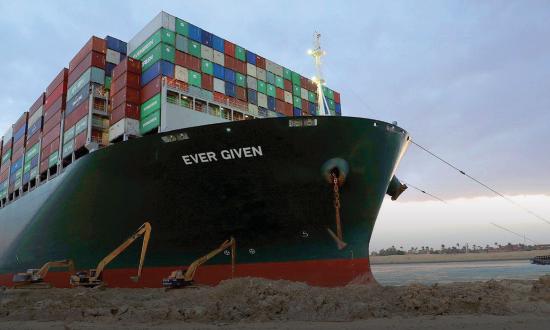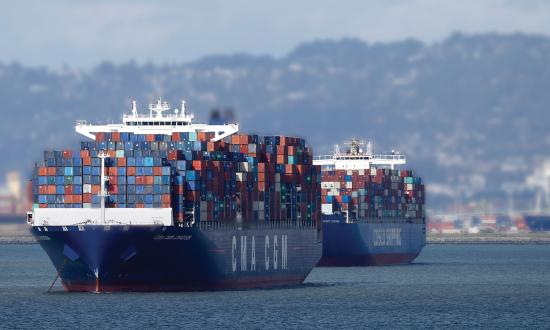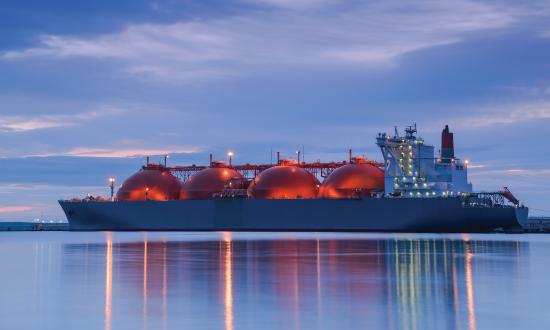The nexus among the world of commercial shipping, geopolitical developments, and the global economy was evident throughout 2022. The economic and political crises that beset the world did not spare the maritime sector. Every aspect of shipping was affected either directly or indirectly during the past 12 months. The world of shipping could not wait for the grim 2022 to end and to reposition itself for 2023 and beyond.
The Global Shipping Market
A year ago, apart from the tanker sector, the industry appeared to be recovering and maintaining that momentum into 2022. What materialized instead was a total reversal, with market fortunes trending down across the board except for the tanker and—partially—the liner markets. Grain shipments from Ukraine dropped to zero the day the Russian invasion began from the 2021 daily average of 137,000 tons until partial resumption six months later. The United Nations Conference on Trade and Development (UNCTAD) estimates that higher grain prices and the dry bulk freight rates that resulted caused a 1.2 percent increase in consumer food prices.1
The International Monetary Fund projected a global GDP growth of 3.4 percent in 2022 and 2.9 percent in 2023, the lowest in more than 20 years. One-third of the nations are already in recession; major economies such as the United States, the European Union (EU), and China are stagnating, and average worldwide inflation galloped to 8.8 percent in 2022. UNCTAD projected maritime trade to grow 1.4 percent in 2022 and 2.1 percent during 2023–27, in contrast with its 3.3 percent average growth during the preceding 30 years. China relegated itself to the backbenches confronting the failure of its COVID-19 policies, and its GDP growth reached only 2.8 percent in 2022 according to a World Bank estimate.
Overall, 2022 was not a good year for shipping. Per the 2022/23 Drewry Report on Ship Costs, the annual ship operating cost rose from 1.3 percent in 2021 to 2.3 percent in 2022, driven primarily by escalating insurance and lubricating oil costs. Operating revenues dropped during the year and even the liner market, despite its recent exorbitant profits, is preparing to lay up ships.
Notably, port congestion has dropped substantially from mid-May 2022, when more than a third of the total fleet capacity was tied up in major gateway ports worldwide. The number of container ships waiting for a berth in U.S. ports was down to 16 by the end of January 2023. The Los Angeles–Long Beach port complex that gained notoriety as the most congested region worldwide has cleared all its backlog, and no ships were waiting at anchor on New Year’s Eve.
Liner Market
The pandemic-induced market demand for consumer goods led to superlative year-end profits, which lasted through the first three quarters of 2022 (as opposed to the usual trend toward barely breaking even). The 2022 year-end profit is now projected to reach about $223 billion, surpassing the 2021 level by more than 50 percent. However, there are clear indications that a market correction has begun, and spot market rates are approaching pre-pandemic levels, ship capacity use rates are declining, and vessel berthing delays are ending. With about 80 percent of liner cargo moving under service contract rates, new contract negotiations will reflect normal freight rates and the two years of windfall profits will end abruptly.
A concern for the market now is the return of overcapacity and the likelihood of a price war among top operators. There has been virtually no scrapping of older container ships in the past two years, and to make matters worse, cash-rich operators have ordered more than 800 large container ships. The three big liner alliances that dominate all major east-west trade lanes now account for more than 90 percent of the market share. Sensing the market turnaround, new entrants to the market are dropping out.
The 2022 Ocean Shipping Reform Act, amending the 1984 U.S. Shipping Act, was enacted on 16 June to regulate certain ocean carrier practices while helping to promote the growth and development of U.S. exports through an “an ocean transportation system that is competitive, efficient, and economical.” The act strengthened the Federal Maritime Commission’s (FMC’s) overall authority and addresses controversial issues such as the Demurrage and Detention clause. Because of its expanded authorities, the FMC is receiving an unusually large number of complaints and has asked market leaders to provide information on how they are complying with the new prohibitions on retaliatory and discriminatory behavior.
Dry Bulk Market
The 2021 economic recovery of dry bulk operators took a step backward in 2022, primarily because of the China-centric nature of dry bulk trades and broader global macroeconomic developments. The World Steel Association estimates that the drop in Chinese domestic demand for steel in 2022 caused a 2.3 percent decline in worldwide demand for iron ore. Similarly, coal shipments to China declined 12.2 percent. The EU sanctions on Russian coal led to both parties finding alternate trading sources located farther away and lengthened the average coal-laden voyage by about a third more than in 2021.
The Black Sea Grain initiative began on 1 August 2022 under intense worldwide pressure on Russia to meet global food security needs. Although a welcome relief to recipient nations, it remains unpredictable and subject to President Vladimir Putin’s appetite for weaponizing critical food shipments. He recently pulled out of the agreement following drone attacks against Russia’s Black Sea fleet in Russian-annexed Crimea. Though these grain shipments are expected to continue into spring 2023 and possibly beyond, the absence of true market conditions does not add comfort.
As scrapping of dry bulk tonnage is expected to exceed the supply of new tonnage in the short run, the market remains poised for recovery once normalcy returns. China’s recent lift of COVID-19 restrictions and partial lifting of the embargo on Australian coal imports are other positive signs for the market.
Tanker Market
After years of poor profits and a painful 2021, the second half of 2022 brought good fortune for tanker owners. Regardless of extraneous political and economic concerns and even the intentional manipulation of oil supply by the Organization of the Petroleum Exporting Countries monopoly, the tanker sector has turned the corner, and a structural bull market is now firmly within its grasp. Adverse market conditions had held back new tanker construction for the past few years. The relatively small number of new tankers scheduled for delivery will be more than offset by the scrapping of old ones. Future tanker capacity may be even less than the current level, which bodes well for the owners. Tanker charter rates are escalating, asset values are ascending, and the sale and purchase market for used tankers is booming.
Among other factors, the ongoing war in Ukraine has had a precipitous impact on the tanker market. The banned 1.5 million barrels per day (MBPD) of Russian oil exports to Europe has been offset by seaborne U.S. exports. The G7 imposition of a price cap on Russian oil exports from 5 December 2022 and the ban on tanker owners that fly any EU flag or carry protection and indemnity (P&I) insurance from an EU Club trading crude oil that originated in Russia have set off a chain of market reactions.2
Russia does not own sufficient tanker capacity to export the 3.5 MBPD shipped routinely to fund its war efforts. Many tanker owners previously involved in the Russian trade have left. Some remain legitimate by carrying oil only under the terms of the G7 price cap, but there is the “dark” fleet of about 300 tankers well past their normal service lives that trade without traditional P&I insurance coverage. Their unscrupulous owners carry Russian oil sold above the price cap. Presently, these ships carry about a fifth of Russian crude oil and Russian ships another 35 percent. Russian crude movements at or below the $60 price cap are legitimate, and there is no restriction on Western shipping or insurance companies handling those cargoes.
Shipbuilding
Although the average age of the world fleet is increasing, new construction activity has been held back because of rising steel and labor costs, inflationary trends, and market uncertainties. On average, newbuild costs escalated about 25 percent in 2022, and new orders declined 22 percent. Statistics from Clarksons Research show that China secured 49 percent of those new orders and South Korea 37 percent. State subsidies have reportedly kept construction costs low in China, while the top three Korean builders lost $3 billion in 2021 and another $1 billion in the first half of 2022. Chinese yards dominate the construction of container ships and are even catching up with the Koreans’ comparative advantage in building liquefied natural gas (LNG) ships.
Some owners are hesitant to invest in fleet renewal because of a lack of clarity on the ideal marine fuel for a net-zero greenhouse gas emission future and the absence of an internationally accepted technical design requirement. Current fuel options include LNG, LNG dual fuel, methanol, ethane, electric hybrid, ammonia ready, and hydrogen ready. Owners appear to favor propulsion systems that can use multiple fuels. Close to 40 percent of all vessels on order have chosen LNG as the fuel of choice, although it is not a zero-carbon source.
The entire global fleet needs to be replaced to meet the 2050 green goal, meaning about 3,500 ships need to be built or refitted every year until 2050. Shipbuilding capacity should grow by 50 percent in the next five years to accomplish this goal, according to Shipping Strategy, a U.K.-based consultant. With nine shipbuilding groups monopolizing the market and a growing skilled labor shortage, challenges in replacing current shipping capacity will intensify in future years.
Cruise Market
The cruise sector has reported a rise in bookings and increase in projected passenger revenue in 2023. Beyond making operational changes, operators are optimizing their fleets and discarding older tonnage. The delivery of new ships has also been slowed to limit supply. Carnival Corporation, the largest operator, reportedly will increase its passenger carrying capacity in 2023 by only 3 percent, although its bookings are now comparable to the pre-COVID-19 days in late 2019.
The U.S. Maritime Sector
Over the past two years, the U.S. maritime industry has received strong support from both Congress and the Biden administration. Substantial commitments have been authorized for port and intermodal infrastructure, sealift recapitalization, and other programs to support economic and national security. The Federal Maritime Commission’s regulatory authority to prevent market abuse by dominant liner operators also received a major boost in 2022. The Maritime Administration’s (MarAd’s) promotional efforts toward both increasing women and minority participation in shipboard careers and championing their fair and dignified treatment on board were codified in the fiscal year 2023 (FY23) National Defense Authorization Act (NDAA).
In 2022, the U.S. Department of Transportation (DoT)/MarAd issued $703 million in grants to improve supply chain reliability through increased port capacity and resilience, enhance operational efficiency, reduce emissions, and provide new workforce opportunities. Among the various approved projects, electrification of port equipment to reduce emissions and improve air quality received $150 million, while port projects that advance offshore wind deployment received $100 million. The FY23 NDAA has authorized $750 million to maintain the momentum in 2023 and beyond.
The prior authorization for a ten-ship Tanker Security Program was doubled in 2022. When implemented, the number of privately owned U.S.-flagged ships will surpass 200 after two decades of decline. Other elements include $318 million for 60 ships in the Maritime Security Program, $15 million for the Maritime Environmental and Technical Assistance program, $15 million for the Marine Highways program, and $30 million for the Small Shipyard Grant program. The national security multimission vessel construction is reportedly on track and within budget, with the first ship to be commissioned in spring 2023 and two more scheduled for delivery in 2024.
Mariner Shortage
The 2021 Baltic and International Maritime Council/International Chamber of Shipping forecast of an escalating worldwide mariner shortage is happening sooner than projected. A recent finding that half of all current mariners may need specialized retraining when zero-carbon fuel becomes the norm will only worsen this shortage. There is also the likelihood of the Philippines—the largest supplier of mariners in the world—losing its mariner training approval status. Closer to home—despite consistent investment in maritime academies and training programs and graduating close to 1,000 entry-level officers each year—U.S.-flagged operators and labor unions are reporting a shortage of qualified mariners.
COVID-19 affected the physical and mental health of today’s mariners. Although U.S. citizen mariners were spared the inhumane treatment that mariners from other nations endured during the past two years, there is widespread professional dissatisfaction. The general mariner apathy and a lack of appreciation for their sacrifices in keeping essential supply chains open during the peak of COVID-19 does not exactly reflect a welcoming environment.3
Overall, the traditional charm associated with working on ships has waned, with port-stay rarely exceeding 24 hours and shore leave options becoming increasingly restricted. The expenses associated with earning and maintaining a U.S. Coast Guard credential add little incentive, especially when career opportunities on board U.S.-flagged ships remain relatively stagnant. Furthermore, for the current generation of mariners, the quality of work life on many ships is below expectations. Even basic conveniences such as online connectivity and email service may be unavailable on some ships or require a payment.
Industry stakeholders have suggested various options to resolve the mariner shortage, including some short-term fixes and even the hiring of unemployed Ukrainian mariners. If the intent is to find a sustainable solution and build a cadre of U.S. mariners to meet national needs, should they not look first within U.S. borders? It is sad that the prevalent demographic profile of a U.S. merchant mariner remains mostly unchanged from World War II days. Whereas the number of women and minorities participating in most other work sectors has grown over the years, the proportion of credentialed female mariners lingers at 7–8 percent.
Tragically, recent horrific reports of shipboard sexual assault, harassment, and bullying incidents suggest that providing a safe and respectable work environment for female mariners remains a far-fetched aspiration. This affects the health and welfare of all mariners on board and even the safety of those ships, and thereby the retention of affected mariners—not to mention the recruitment of new ones. How will the nation sustain the limited supply of qualified mariners today if the industry fails to attract more women and minorities to pursue a career at sea?
The MarAd effort to change industry culture beginning with the introduction of Every Mariner Builds a Respectful Culture (EMBARC) standards is now in its second year. The FY23 NDAA has added teeth by codifying the availability of federal support contingent on adherence with those standards and including the company’s sexual assault and harassment prevention and response policies in the vessel’s safety management system. Certain EMBARC provisions will become mandatory for all U.S.-flagged ships and will be enforced by the U.S. Coast Guard. These measures are long overdue to build a respectable shipboard work culture for all and inspire the next generation of mariner workforce.
1. In a typical year prior to the invasion, Ukraine and Russia would account for 30 percent of world’s wheat and barley, 20 percent of maize, and 50 percent of sunflower oil.
2. Unless it was sold by Russia to the buyer at or under the agreed price cap, which is currently $60 per barrel. This is reportedly causing Russia a net loss of $170 million per day.
3. An extreme case was when several nations did not allow a foreign-flagged ship to even send back home the body of its captain, who died on board from natural causes.








